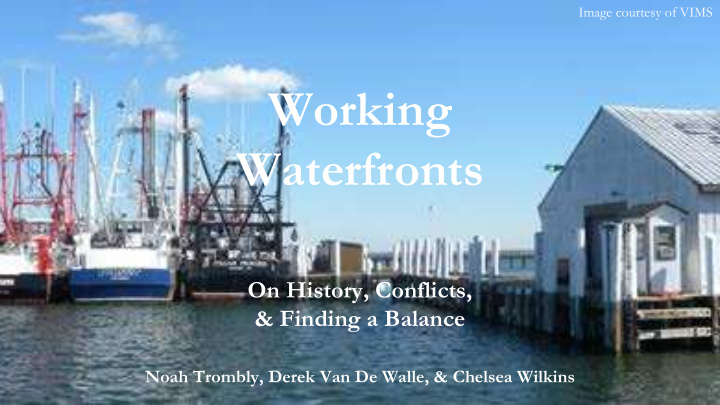



Image courtesy of VIMS Working Waterfronts On History, Conflicts, & Finding a Balance Noah Trombly, Derek Van De Walle, & Chelsea Wilkins
What is a Working Waterfront? Working waterfronts are areas or structures on, over, or adjacent to navigable bodies of water that provide access to the water and are used for water-dependent commercial, industrial, or government activities, including commercial fishing, recreational fishing, tourism, aquaculture, boat and shipbuilding, boat and ship repair, boat and ship services, seafood processing, seafood sales, transportation, shipping, marine construction, military activities and other water dependent uses. Virginia Working Waterfront Master Plan (July 2016).
The Issues: Development, Aquaculture, and Property Rights The Lynnhaven: The Ware: The Eastern Shore: ● Resurgence of aquaculture ● Newer conflict ● Development pressures and ● Conflicting uses between activities vs. interests of the loss of working some riparian owners some residential owners & waterfronts: development in ● Riparian owners feel left aquaculture industry Cape Charles ● Residential owners feel left out of the regulatory ● Potential conflict between process out of the conversation, SAV and clam aquaculture: ● VMRC lacks the authority including the regulatory SAV restoration may limit to resolve the conflict process clam aquaculture expansion ● Residents feel they do not absent changes to the VA Code have the same access to the water that they used to have
Threats to ~600 Working Waterfronts in Operation in Coastal Virginia Changing global economy • Increasing competition • Increasing government regulations • Decline in water quality and fisheries habitat • An aging workforce • Vulnerability to increasing natural threats (sea • level rise, frequency and magnitude of storm events, land subsidence, shoaling of navigable channels, etc.) Land and water conflicts • VA Working Waterfront Master Plan
Key Statutes & Regulations Price per acre, duration and renewal (§ 28.2-612; § 28.2-613) • Notification procedure (§ 28.2-606) • General Permit #4 For Temporary Protective Enclosures (4 VAC 20-1130-10) • Cages exceeding 12 inches from the bottom • Notice procedure • Authorization of Shellfish Aquaculture Structures (4 VAC 20-335-10) • Cages less than 12 inches from the bottom • No notice procedure • Regulations on dredging (4 VAC 20-70-10) • SAV takes priority (4 VAC 20-335-30(F)) •
- Chesapeake EcoCheck
The Lynnhaven River o Golden Age of the Lynnhaven Oyster Ideal conditions • Consumed by dignitaries along the East Coast and beyond • o Water Quality VA Beach Population o 1900s • 1900s: 11,000 • 1930 - First shellfish condemnation • 1980: 262,199 1971 - Entire river closed to shellfish • • 1998 - Listed “impaired” on CWA § • Now: 453,000 • 303(d) o Today, 44% of the Lynnhaven is open for shellfish harvest
Recent Developments Riparian Owners Safety, water access, property Property rights value, visual pollution, and privacy Utilizing natural resource to Commercial Watermen make a living in a manner Economic encouraged by the state
Recent Developments ● Senate Bills 254 and 298 ● Taskforce and moratorium on new leases ● Commission votes for status quo Recommendations With ● Upcoming legislation? Consensus Notice procedure for all cages • Use plan for leases • Riparian rights for oyster • ground leases Raise awareness •
The Ware River
Courtesy of VMRC
Aquaculture & the Ware ● History on the Ware ● Algae-rich water ● General Permit 4 ○ Notice Requirement ○ Allows for the placement of up to 2500 cages on 18 acres of leased ground ○ Annual payment of $625 ○ 2-foot tall cages ● Changing aquaculture methods
Personal Pictures & The Daily Press
The Eastern Shore Development Pressures: The Oyster Farm at King’s Creek Marina & the Bay Creek Development: ● Prior to Redevelopment ○ Hub for fishermen on the Eastern Shore ● Development & its Consequences ○ Rise of the “Dockominiums” ○ Moratorium on crabbing ○ Displacement of the fishermen to the Town Harbor and loss of commercial watermen ○ Focus switches to tourism
The Eastern Shore SAV and Clam Bed Aquaculture: ● Benefits of SAV ○ Habitat ○ Primary Producer ○ Settle sediment and reduce wave velocity ● Benefits of Clams ○ Natural filter ○ Economic impact ● Why these uses may conflict ○ Uses compete for space ○ Dredging and scarring ○ VMRC regulations - SAV takes priority ○ Clam aquaculture unable to expand
Courtesy of Center for Coastal Resources Management at VIMS
Courtesy of Center for Coastal Resources Management at VIMS
Final Observations Maintain open communication • between landowners, industry, and government Increase understanding of aquaculture • and working waterfronts among the public Preserve historic working waterfronts • Encourage water-dependent businesses • Scaling industry to fit the locality •
Recommend
More recommend